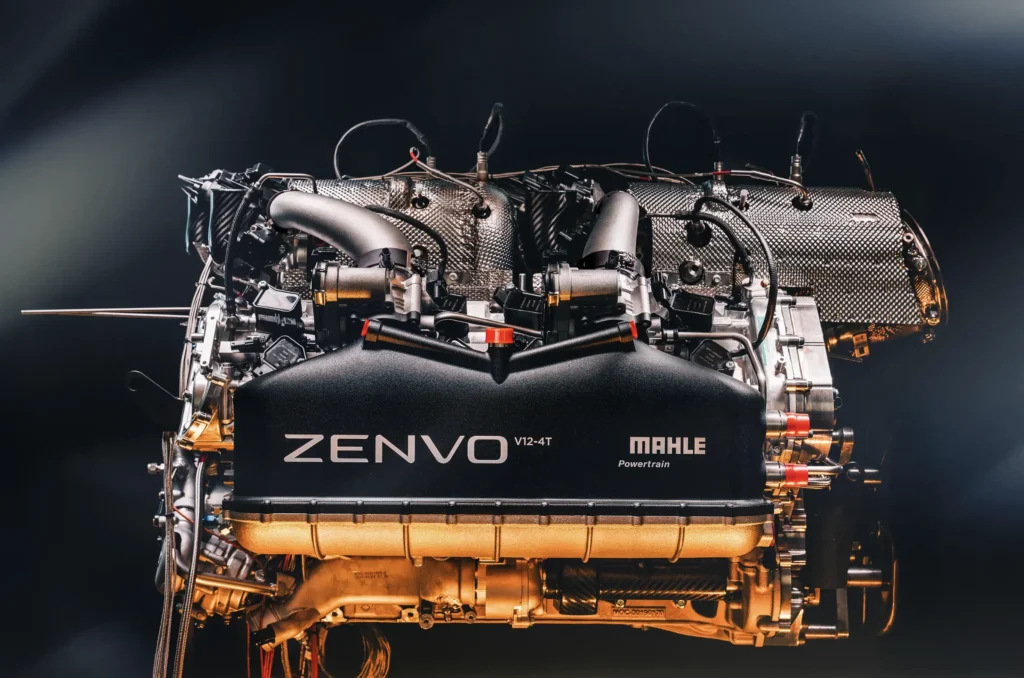When it comes to high-performance automotive engineering, the internal combustion engine isn’t dead yet—in fact, it’s evolving. Enter Jet Ignition Technology (JTI), a revolutionary advancement designed to boost efficiency and reduce emissions in powerful engines. And leading this innovation is the Zenvo Aurora, a Danish hypercar packing a bespoke, quad-turbocharged V12 engine that rewrites the rulebook.
Since PRV Engineering works across a range of sectors—including automotive, where precision, performance, and innovation are essential—we were particularly excited by this recent breakthrough. As a company passionate about cutting-edge technology and engineering excellence, we believe this development deserves a closer look.
This article explores how Zenvo’s bold approach to combustion, hybridisation, and engineering precision could inspire wider automotive applications—and why Jet Ignition might just extend the life of the combustion engine in a greener world.
A New Breed of Supercar Engineering
Unveiled by Zenvo Automotive, the Aurora is a limited-edition hypercar combining a 6.6-litre quad-turbo V12 engine with an electric hybrid system. The result? An estimated 1,850 horsepower and a top speed of 280 mph.
The centrepiece of the Aurora is its engine—developed in partnership with MAHLE Powertrain and designed completely in CAD without a single prototype. The cylinder heads are milled from solid aluminium billet using CNC machining, which aligns closely with PRV’s approach to precision manufacturing. You can learn more about our CNC capabilities here.
The Aurora’s engine, named Mjølner, doesn’t just impress with raw power. Its innovation lies in how it burns fuel more efficiently than any comparable V12, thanks to a game-changing technology: Jet Ignition.
What is Jet Ignition Technology and Why Does It Matter?

Originally developed by MAHLE, Jet Ignition technology replaces traditional spark ignition with a two-stage combustion process. Here’s how it works:
- A pre-chamber above the piston ignites a small, ultra-lean air-fuel mixture.
- The resulting jet flame is then blasted into the main combustion chamber.
- This initiates an even, high-pressure burn across the cylinder.
The result is a more complete combustion process, with lower emissions, better fuel economy, and the ability to run leaner fuel mixtures at higher compression ratios. In Zenvo’s case, this means keeping a V12 relevant in an age dominated by electrification.
MAHLE states that Jet Ignition technology can reduce fuel consumption by up to 20% compared to conventional spark ignition, while cutting particulate emissions by a significant margin. Watch this video on how this technology works; it’s fascinating to say the least!
Engineering Precision: From Simulation to Cylinder Head
Zenvo’s Mjølner engine was created entirely through simulation, with zero physical prototyping—a testament to the power of modern engineering tools and manufacturing processes.
Once the digital design was finalised, the engine’s components—including its complex cylinder heads—were CNC-milled from solid aluminium blocks. This approach not only reduces development time, but also ensures unmatched precision.
At PRV, we understand how essential accuracy and repeatability are in automotive components. From deep hole drilling to custom fabrication, our work supports the same values that drive projects like the Aurora.
Sustainability in Supercars: Is Combustion Still Relevant?
The Aurora is not just about speed; it’s also about sustainability. With global pressure mounting to reduce vehicle emissions, even the supercar world must adapt.
Zenvo’s answer is to hybridise—combining Jet Ignition Technology with electric propulsion. This creates a more sustainable supercar, capable of achieving extreme performance while producing fewer emissions.
For a combustion engine to thrive in the future, it must be cleaner and smarter. Technologies like Jet Ignition provide a pathway for that, potentially influencing not only niche hypercars but also broader motorsport and commercial applications. In fact, related technologies have already been deployed in Formula 1, where efficiency is paramount.
Recommended: Creating The Ultimate Supercar Engine – Gordon Murray T.50
The Future of High-Performance Automotive Engineering
Zenvo’s Mjølner V12 may be exclusive to just a few dozen lucky buyers, but the concepts behind it—efficient combustion, digital-first design, and hybrid integration—are influencing the next generation of automotive engineering.
One area where innovations like this intersect with broader applications is in the design of busbars, which are essential for EVs, hybrid vehicles, and even motorsport electrification. As energy demands grow, so too does the need for efficient current distribution and component design.
At PRV, our multi-sector experience means we can apply lessons from motorsport to energy, defence, rail, and more. Because whether it’s a V12 hypercar or a high-load power system, engineering excellence is always the goal.
Interesting Read: Mission X Concept Hypercar Is Porsche’s Vision of Tomorrow
Final Thoughts: The Role of Jet Ignition Technology in a Hybrid Future
The Zenvo Aurora’s Mjølner engine proves that the internal combustion engine isn’t going away quietly. Instead, it’s evolving—becoming cleaner, more efficient, and even more impressive.
Jet Ignition Technology represents a major leap forward in combustion design, offering a route to sustainability without sacrificing performance. As PRV continues to support clients across the automotive and motorsport industries, we remain excited by what innovations like these mean for the future of engineering.
Read the original article here: New Atlas – Zenvo’s Jet Ignition V12
Explore more about our work in automotive, manufacturing, and precision engineering at www.prv-engineering.co.uk


Recent Comments